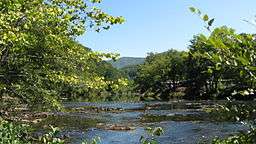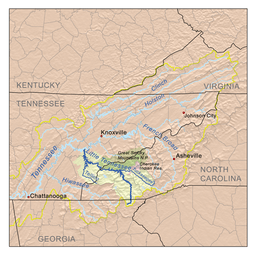Tuckasegee River
| Tuckaseigee River | |
 View upriver from Old River Rd. above Bryson City
| |
| Country | United States |
|---|---|
| State | North Carolina |
| Part of | Little Tennessee → Tennessee → Ohio → Mississippi |
| Tributaries | |
| - left | West Fork Tuckasegee River, Savannah Creek, Barkers Creek, Connelley Creek, Kirkland Creek |
| - right | Tanasee Creek, Caney Fork, Wayehutta Creek, Mill Creek, Scott Creek, Dicks Creek, Camp Creek, Oconaluftee River, Cooper Creek, Deep Creek, Lands Creek |
| Source | confluence of Panthertown and Greenland creeks |
| - elevation | 3,969 ft (1,210 m) |
| - coordinates | 35°10′6″N 83°0′41″W / 35.16833°N 83.01139°W |
| Mouth | |
| - location | Lake Fontana |
| - elevation | 1,703 ft (519 m) |
| - coordinates | 35°26′5″N 83°35′4″W / 35.43472°N 83.58444°WCoordinates: 35°26′5″N 83°35′4″W / 35.43472°N 83.58444°W |
| Length | 60 mi (97 km) |
| Basin | 655 sq mi (1,696 km2) |
| Discharge | for Bryson City |
| - average | 1,584 cu ft/s (45 m3/s) |
| - max | 61,600 cu ft/s (1,744 m3/s) |
| - min | 31 cu ft/s (1 m3/s) |
 The Little Tennessee drainage basin | |
The Tuckaseigee River (variant spellings include Tuckasegee and Tuckaseegee) flows entirely within western North Carolina. It begins its course in Jackson County above Cullowhee at the confluence of Panthertown and Greenland creeks. It flows in a northwesterly direction into Swain County and through the center of Bryson City, North Carolina. The river passes around the Bryson City Island Park, where it then enters Fontana Lake and then the Little Tennessee River.
The name Tuckaseigee may be an anglicisation of the Cherokee language word daksiyi—[takhšiyi] in the local Cherokee variety—‘Turtle Place.’ The river is dotted with stone fishing weirs built by Native Americans; this practice may have preceded the Cherokee in the area. The weirs are most easily viewed when water levels are low.[1]
A more likely etymology of the word refers to the Tokah or Tokee (Spanish - TocaE) People, who occupied Jackson County, NC in the late 16th century and 17th century. On several occasions Spanish explorer, Juan Pardo, met with their leaders.[2] In that case, Tuckasegee would be the Anglicization of a word that was either originally Muskogee-Creek or hybrid Muskogee-Creek & Cherokee. It is impossible to determine whether it was entirely a Creek word, because the Muskogee “Ki” sound is typically spelled in English with the same letters as the Cherokee “gi” sound. Tvkah-se-ki is translated in Muskogee as "Colony of Tokah People." [3]
Fishing, hiking and paddling are among the recreational opportunities along the river.
It was the location used for the trainwreck / river escape scene in the movie "The Fugitive", starring Harrison Ford.
References
- ↑ See Anne Frazier Rogers, “Fish weirs as part of the cultural landscape,” Appalachian Cultural Resources Workshop Papers, National Park Service. Photo of the Allman fish weir discussed in the paper.
- ↑ Bandera, Juan de la (1569) "Relacion dela Florida - 1567-1568). Translation by Herbert Ketchum (1950); p, 56.
- ↑ Martin, Jack B. & Mauldin, Margaret McKane (2000) A Dictionary of Creek/Muskogee. Lincoln: University of Nebraska Press; p. 241.
"Tuckaseigee River". Geographic Names Information System. United States Geological Survey. Retrieved 2010-07-01.